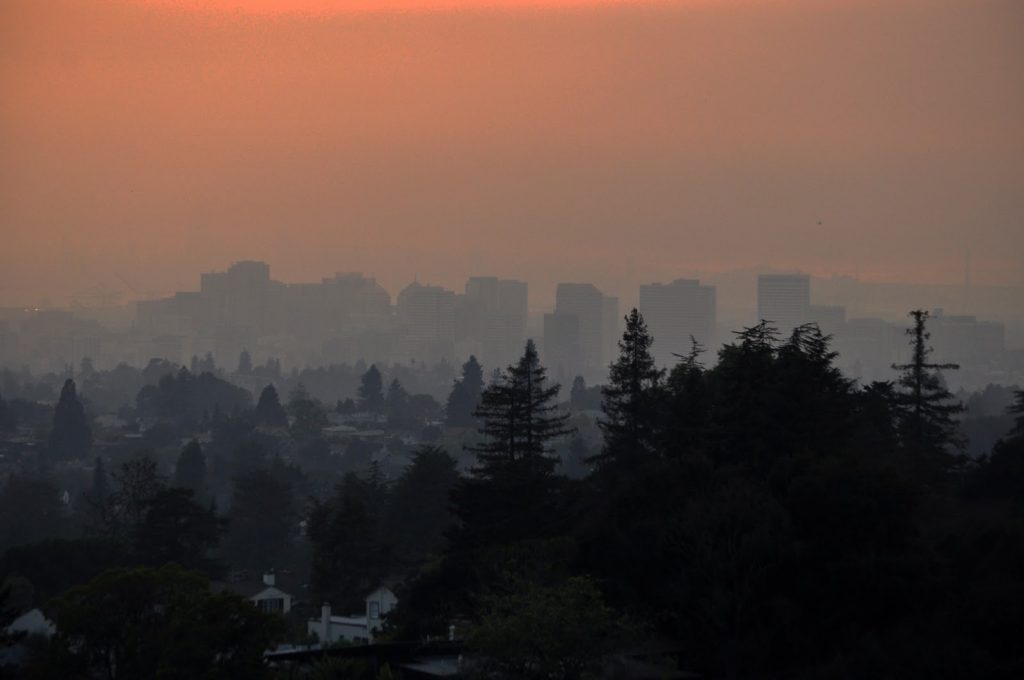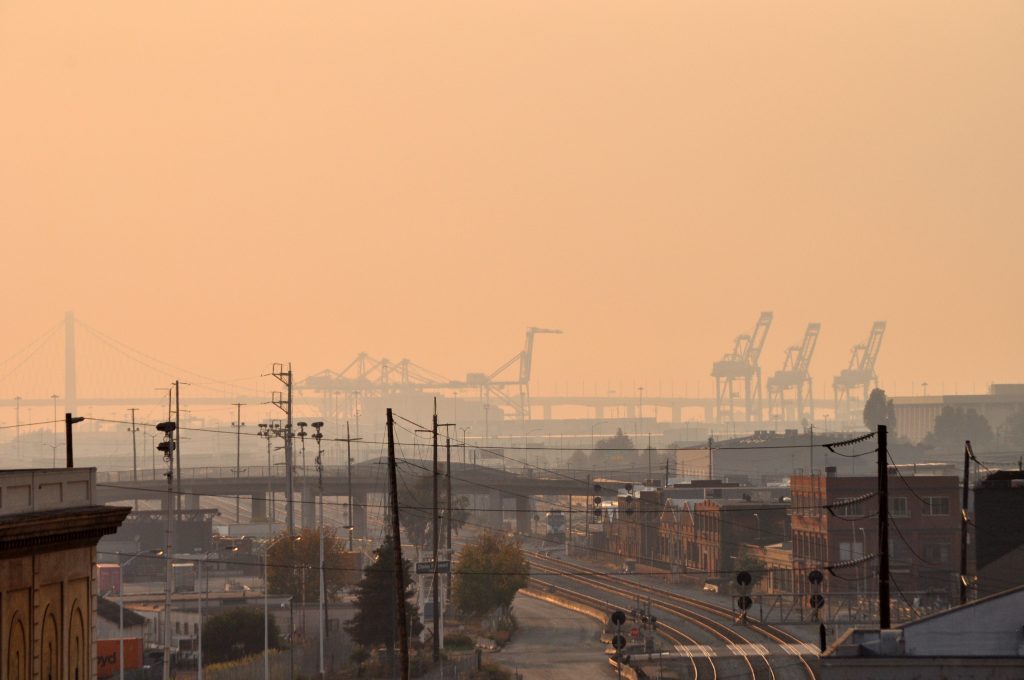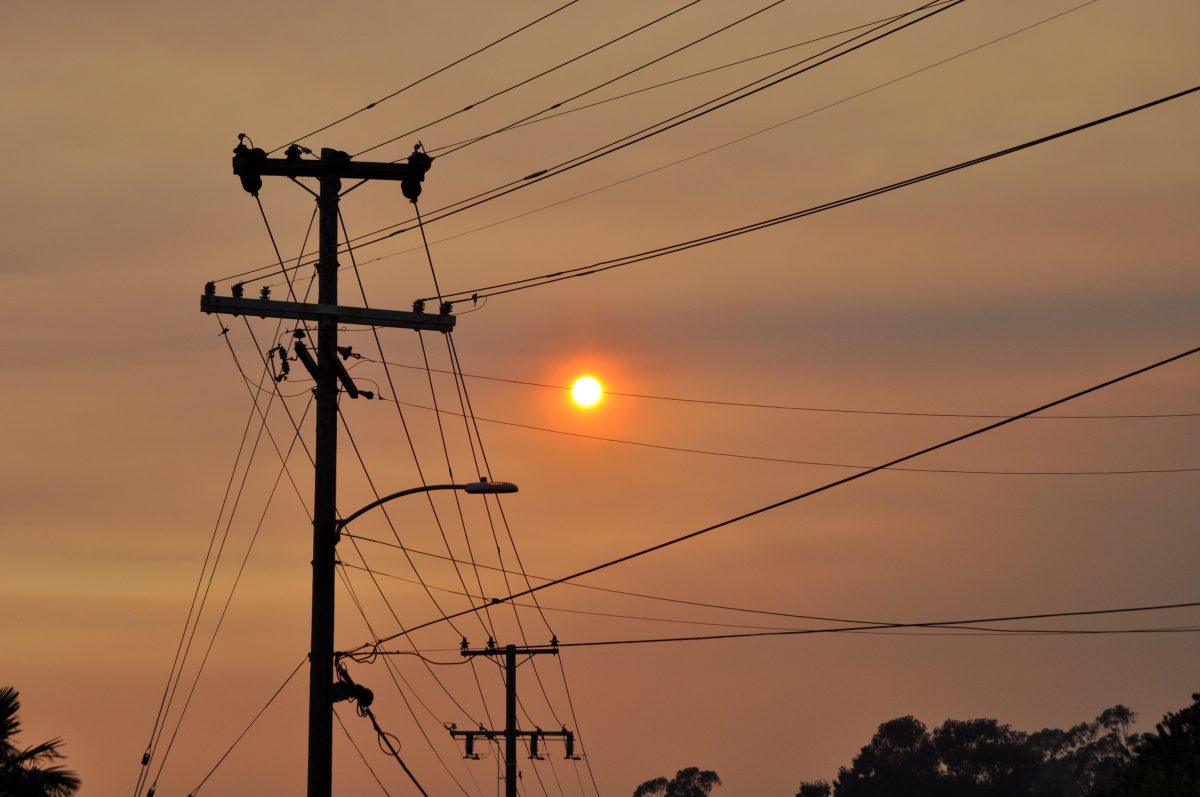Over the past week, frightening weather patterns have disrupted our communities and strained public resources and utilities. The recent heatwave, expected to last the entire week, has seriously impacted the state’s electricity supply, leading many Oaklanders to wonder if rolling blackouts are around the corner.
Oakland didn’t experience power outages related to the heatwave or fires this week or last week—an outage affecting about 16 households in Glenview on Sunday was due to previously scheduled maintenance. But hundreds of thousands of residents lost power in other nearby counties over the weekend, and the blackouts reminded many of last year’s shutoffs, which began in the Bay Area and impacted three million people during an intense fire season.
The Oaklandside looked into who manages and operates California’s power grid, how they responded to this week’s heatwaves and other unforeseen events, how much advance notice residents can expect about power shut offs, and how to sign up for alerts and better prepare for rolling blackouts.
What are rolling blackouts, and why are Bay Area residents experiencing them?

The California Independent System Operator (CAISO), one of the largest grid operators in the world, manages about 80 percent of the state’s electrical grid. Based in Folsom, they’re the ones who order utility companies to shut off power and, when there’s enough time for advance warning, send out alerts to residents.
When CAISO anticipates strain on the state’s power grid because people are using too much energy relative to the overall supply, they tell utility companies to start conducting rotating power outages, commonly known as “rolling blackouts.” These outages are known as Stage 3 Emergencies, and you can find out about them by signing up for Flex Alert phone or email notifications. According to CAISO, these outages become necessary when the demand on the grid threatens to outpace the electrical reserves CAISO is required to maintain at all times by state law.
“This is not a transmission problem,” said CAISO vice president Mark Rothleder at Monday’s press briefing. “This is a supply, resource, and capability problem.”
CAISO determines whose power to cut off by grouping customers into rolling, or rotating, “blocks” and turning electricity off for targeted blocks for up to two hours at a time. You can look up your block using this tool from PG&E. If your block comes up as “50,” you’re unlikely to be affected by power outages because your address may be on the same circuit as a hospital, police station, fire station, or other critical facilities.
During rotating outages ordered by CAISO, PG&E usually exempts locations like prisons, radio and TV broadcasters, some healthcare facilities, and other places that provide essential public health, safety, and security services from losing power if they don’t have adequate back-up generation for up to two hours. PG&E has a partnership with the California Foundation for Independent Living Centers to provide backup batteries and hotel rooms for individuals who rely on ventilators and other life-support devices.
Andy Campbell, executive director of U.C. Berkeley’s Haas Energy Institute, said the rules governing the timing and locations of outages go back to the state’s 2000-2001 electricity crisis, when 1.5 million customers in California lost power in the state’s first blackout. That crisis—with 38 blackouts total—was exacerbated by a drought and the fact that three major utilities were dealing with severe financial problems at the time.
Several reasons lie behind recent power outages: hot temperatures leading to increased electricity demand, and unstable generation of wind power on Saturday due to heavy gusts.
CAISO also confirmed the temporary loss over the weekend of two power plants at a Monday press briefing, but didn’t share many details. That loss in power also played into CAISO’s decision to rotate power shut-offs around the state.
Campbell acknowledged the hard decisions CAISO had to make this past weekend. “They have a tough job of keeping the system up and running,” he said. “The reason they black out some customers is so they can then keep power going to all the others. If supply and demand is out of whack, the whole system can collapse, and that could be very difficult to recover from.”
This weekend’s Bay Area power outages were not the same as PG&E’s Public Safety Power Shutoffs (PSPS), which are conducted in high fire-threat conditions to reduce the likelihood that a falling tree or faulty transmission line will cause a spark and fire. PG&E does not anticipate shutoffs this week, though there is always a chance it will happen later this fire season, which has started earlier than it did last year.
Along with heatwave-induced unplanned power outages like the ones we saw this weekend, fires can impact transmission lines and cause outages, too, though that fortunately hasn’t happened yet this summer.
How do I sign up for outage alerts, report a power outage, see real-time usage stats, and more?
Sign up for Flex Alerts: These statewide alerts from CAISO notify people of possible power outages. They’re usually sent during the summer when higher temperatures lead to higher electricity demand. Higher demand usually happens in the evening when solar-powered generators go offline but demand is still high due to more lights, air conditioners, and appliances turning on.
Sign up for AC Alerts: Alameda County’s emergency notification system sends alerts about extreme weather events and red flag warnings about high-risk fire conditions, as well as COVID-19 pandemic updates, police activity, and more. You can tweak your settings to choose what types of alerts to receive.
Sign up for Cal Alerts: Similar to AC Alerts, but for other counties in the state.
CAISO website en Español: Visit the CAISO website in Spanish.
Check out power usage in real-time: This website shows past and present outlook for the amount of electricity used by customers statewide, real-time capacity, and the forecasted peak.
PG&E’s Rotating Power Outage Block Locator: You can use this tool to find out if your address is going to be impacted by a planned power outage.
Power Outage Incidents: Track recent power outages using the state’s geoportal.
Report a power outage: The next time you experience or hear about a power outage, you can report it to PG&E’s Outage Center to help them better track and address problems.
How far in advance does CAISO warn Californians about potential power shutoffs?
CAISO says Flex Alerts are most effective when issued just one day in advance of a potential shutoff, and that it will issue the alert by 3 p.m. the day before. But CAISO also warns on its website that grid emergencies can happen suddenly, and result in little to no advance notice to customers and utility suppliers like PG&E.
On Friday, there was no advance warning for the 300,000 residents who lost power for more than two hours in El Dorado, Marin, Napa, San Mateo, and Sonoma counties following a request from CAISO. On Saturday, 234,000 customers lost power for more than an hour in Monterey, Santa Cruz, and San Joaquin counties. They didn’t get a warning, either. Then on Monday, 3.3 million customers across the state were forecasted to lose power. Fortunately, none did.
For its part, PG&E doesn’t send alerts to customers when it gets the signal to shut off power from CAISO. “Due to the emergency nature of the order to offload, we are unable to notify customers before shutting off power,” said PG&E spokesperson Katie Allen about Friday and Saturday’s outages. She added that PG&E only gets a 10-minute window to initiate and complete the shutoffs.
The last time CAISO issued a Flex Alert was in 2010, and there hasn’t been a Stage 3 Emergency alert since the 2001 energy crisis. Since then, CAISO officials have pointed to consumer conservation as one of the leading factors helping to stabilize the power grid. It’s what helped prevent further outages this week.
After doing their part to conserve energy, many in the community have lambasted CAISO and PG&E for their lack of communication leading up to the power outages.
“You put your finger on a very important shortcoming of the situation—the communication,” said Andy Campbell, executive director of U.C. Berkeley’s Haas Energy Institute. “[CA]ISO, utilities, and large organizations need to be brought into that.”
What’s being done to prevent rolling power outages in Oakland?

California relies heavily on wind and solar energy, but these renewables make the state more susceptible to supply-demand imbalances during extreme weather events. Solar and wind aren’t always reliable, and, unlike gas-fired power plants, they can’t be quick-started to add extra electricity when demand spikes.
“There’s a trade-off there that state policymakers need to really take a fresh look at,” said Andy Campbell, executive director of U.C. Berkeley’s Haas Energy Institute. “This situation has shown that there’s a lot of value to having natural gas power plants on stand-by as an insurance policy, even if we don’t really use them very much.”
But many of the state’s pre-existing plants are located in low-income areas with mostly residents of color. “They’re already suffering from a lot of environmental harm and other harms over many decades,” said Campbell. “There are important conversations about environmental justice that need to be worked through.”
Campbell believes we need to plan for the most extreme conditions, not just the normal and unusual days. He’d especially like to see California take advantage of opportunities to import some of the large amounts of hydroelectric power being generated in the Pacific Northwest.
Lucas Davis, professor at UC Berkeley Haas School of Business, watched wholesale electricity prices skyrocket on Friday. He thinks customers could shoulder more of the burden, especially if extreme heat events happen once every 10 to 20 years—though he acknowledged they could happen more frequently going forward due to climate change.
“When the wholesale price goes way up, the price should go up for people,” said Davis. “Then you wouldn’t need to have as many natural gas plants sitting around. We could pass a price on to customers and allow them to respond and use less energy.”
Coming out of this current heatwave, CAISO officials and energy experts agree that the California Energy Commission and the California Public Utilities Commission (CPUC), the state agencies responsible for planning the electric system, need to take a fresh look at projections on supply and demand.
During a meeting of its board of directors on Monday, CAISO CEO Steve Berberich stressed that CAISO is just “the system operator,” under the California Public Utilities Commission’s direction but that even so, this weekend’s immense blackouts could have been avoided, and said the CPUC’s Resource Adequacy Program, which provides resources to CAISO, needs to be reformed.
“We see how the grid operates and we tell the regulatory authorities how the grid operates,” said Berberich. “I guess we’re going to have to do a better job of making our voice heard through all of that noise.”
CAISO vice president Mark Rothleder said at Monday’s press briefing that one lesson learned is the need for better ability to forecast future events, like cloud cover over solar fields and changes in wind patterns.
On Wednesday, Berberich told reporters the three statewide agencies in charge of the electrical grid are working together to come up with a better sense of what the system’s current capacity is, and what it might be going forward. He didn’t share a timeline for when this would happen. Meanwhile, Governor Gavin Newsom opened an investigation on Monday into all three energy entities, demanding answers.
How can I help reduce energy consumption during the next heatwave?
PG&E advises its customers to reduce energy use during the afternoon and evening, usually between the hours of 3 p.m. and 10 p.m.
Customers can:
- Raise the thermostat: Run your air conditioners like normal in the mornings. Set the thermostat to 78 degrees when at home during the rest of the day, health permitting. When you’re not home, turn it up to 85 degrees or turn it off.
- Use a ceiling fan: Turn on a ceiling fan when using the air conditioner, which will allow the thermostat to be raised about four degrees to save on cooling costs while keeping you comfortable. Turn off fans and lights when you leave the room.
- Cover windows: Use shade coverings and awnings so the air conditioner won’t have to work as hard to cool the home.
- Avoid using the oven: Cook on the stove, use a microwave, or grill outside.
- Limit the opening of refrigerators, which are major users of electricity in most homes. The average refrigerator is opened 33 times a day.
- Clean clothes and dishes early: Use large energy-consuming appliances like washing machines and dishwashers earlier in the day or late at night, after 10 p.m.

